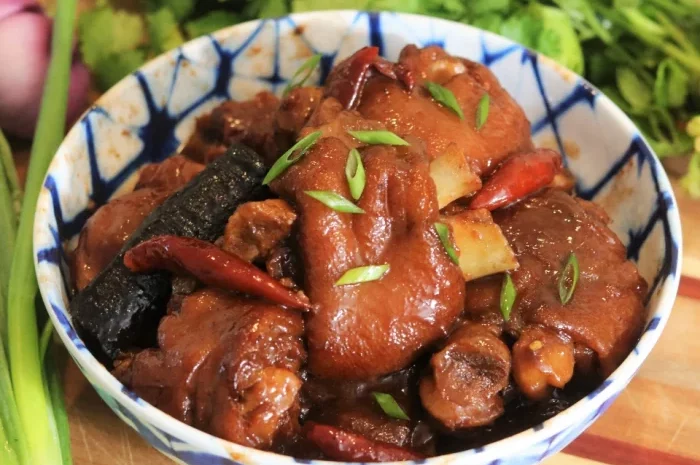Pork Adobo is a delicious Filipino dish that is loved for its sweet and sour taste and rich aroma. When cooking pork Adobo in Chinese style, attention needs to be paid to the heat and seasoning to ensure the best expression of its texture and taste. This article will explain in detail how to cook Adobo pork in a professional way from the aspects of ingredients, handling, cooking and seasoning.
Material Selection
When purchasing pork, you should choose fresh, odor-free, disease-free and injury-free pork. It is best to choose rural or reputable supermarkets to buy to ensure the hygiene and quality of pork. Here’s how to choose fresh pork.
Appearance: Fresh pork should look bright, smooth, and free of damage and cracks. If there are cuts or cracks on the surface of the pork, it may be out of date or not of good quality.
Smell: Fresh pork should have no odor, and if you smell a pungent odor, it means the pork may be spoiled or contaminated.
Touch: Fresh pork should be elastic. If the pork is soft or sticky, it may be out of date or of poor quality.
Treatment
Cut Pork: Cut the pork into evenly sized chunks for easier flavor when cooking.
Marinated Pork: Put the cut pork into a bowl, add an appropriate amount of salt, sugar, cooking wine, ginger, onion and other seasonings, stir well and marinate for 15-20 minutes to increase the taste and taste of the pork.
Cooking
Braised Pork Adobo: Remove the marinated pork and put it in the pan, add the appropriate amount of oil, garlic, ginger, dried chillies, star anise, cilantro, salt, sugar, soy sauce,
Vinegar and other seasonings, stir-fry with high heat, add water, simmer for 1-2 hours, until the pork is soft and rotten.
Stewed Pork Adobo: Put the marinated pork into the pot, add an appropriate amount of water, ginger slices, scallions, cooking wine, salt and other seasonings, bring to a boil, turn to a low heat and simmer for 2-3 hours, until the pork is soft and rotten.
Fried Pork Adobo In Soy Sauce: Remove the marinated pork, put it in the pot, add appropriate amount of oil, green onion, ginger, minced garlic, dried chili, Sichuan pepper, salt, sugar, light soy sauce, dark soy sauce and other seasonings, stir-fry until the surface of the pork is slightly yellow.
Seasoning
Pork Adobo seasoning can be selected according to personal taste, usually can add salt, sugar, soy sauce, cooking wine, ginger, onion, Sichuan pepper, pepper, vinegar and other seasonings to increase the taste and taste of pork. Here are some common seasoning methods.
Braised Seasoning: The seasoning of braised pork Adobo is complicated and requires adding a variety of seasonings to increase the taste and taste of pork. Usually you can add oil, garlic, ginger, dried chili, star anise, cilantro, salt, sugar, soy sauce, vinegar and other spices.
Consomme: The seasoning of clear pork Adobo is relatively simple, only need to add an appropriate amount of water, ginger, spring onion, cooking wine, salt and other seasonings can be.
Sauce Seasoning: The seasoning of sauteed pork Adobo requires careful control of the amount of salt and sugar to avoid being too salty or too sweet. Usually you can add oil, green onion, ginger, minced garlic, dried chili, Sichuan pepper, salt, sugar, light soy sauce, dark soy sauce and other seasonings.
Precautions
Cooking Time: Cooking time is an important factor affecting the taste of pork, too long or too short will affect the taste. Generally speaking, braised pork Adobo needs to be simmered for 1-2 hours, clear pork Adobo needs to be simmered for 2-3 hours, and fried pork Adobo needs to be stir-fried until the surface is slightly brown.
Control Of Heat: The control of the heat is also an important factor affecting the taste of pork, too strong fire will make the surface of pork charred, and too small fire will make the pork undercooked. Generally speaking, braised pork Adobo needs to be stir-fried in a large fire and then turned to a low fire for braising, stewed pork Adobo needs to be boiled in a large fire and then turned to a low fire for simmering, and sauced pork Adobo needs to be stir-fried in a large fire.
Evenly Seasoned: The seasoning needs to be evenly spread on the surface of the pork to increase the texture and taste. During the cooking process, the pork can be constantly turned with a spoon to spread the seasoning evenly on the surface of the pork.
Conclusion:
Cooking pork Adobo requires attention to heat and seasoning, and selection and handling are also very important links. Braised, stewed and sauced are three common cooking methods, each of which has its own unique taste and taste. During the cooking process, adjustments can be made according to personal tastes and preferences to obtain the best cooking results.
Related topic:



























